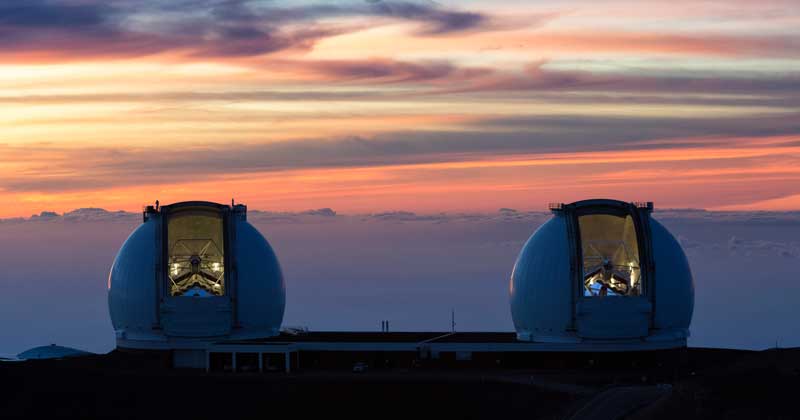


‘Portal to the Universe’ on Sept. 26
Photo courtesy of W.M. Keck Observatory September 14, 2018
10 Keck Observatory facts for Vernon Lecture
The W.M. Keck Observatory in Hawaii houses twin telescopes that are among the world’s largest, most precise and most productive, helping astronomers unlock the secrets of the cosmos.
“Some of the most important astronomical discoveries of recent years have come from Keck,” says Hilton Lewis, director of the observatory. “Some of the biggest mysteries of the universe have been revealed. That’s a tribute to these wonderful telescopes and the talented astronomers who use them.”
On Wednesday, Sept. 26, a Delaware audience will have the opportunity to hear Lewis describe the observatory and elaborate on how astronomy is conducted from the Keck’s perspective.
Lewis will deliver the Harcourt C. “Ace” Vernon Memorial Lecture, titled “W.M. Keck: A Portal to the Universe,” at 7:30 p.m. at the University of Delaware’s Clayton Hall Conference Center. The lecture is free and open to the public; to ensure seating, register here.
The lecture is sponsored by the Mount Cuba Astronomical Observatory in Greenville, Delaware, in conjunction with the Delaware Asteroseismic Research Center at UD and the Mount Cuba Foundation. Vernon was one of the Mount Cuba Observatory’s founders and the first chairman of its board of trustees.
In advance of the lecture, Lewis shared some thoughts about the Keck observatory and his work. Here are 10 things to know:
1. Really? This is Hawaii? A tourist venturing to the domes that house the telescopes might well be surprised by the landscape. Snow-covered and with no vegetation, the site nearly 14,000 feet up the mountain Maunakea is a “spectacular” alpine desert, Lewis says. Winds can reach 100 mph, and temperatures can abruptly drop below freezing. Telescope operators who work there are acclimated to the thin, cold air, but visitors sometimes start to feel ill and less mentally alert.
2. Location, location, location. Even if the site doesn’t resemble a tropical paradise, its location is heavenly for astronomers. The atmosphere above the telescopes is generally clear and dry, with very little light pollution and no nearby mountains to disturb the upper atmosphere. “It’s probably the best place in the world to do astronomy,” Lewis says.
3. No need to scale the summit. The long trek to the telescopes themselves isn’t actually necessary for scientific observation. Astronomers who are allotted time on the Keck telescopes conduct their observations remotely. About half come to the observatory’s headquarters in Waimea, Hawaii (elevation a mere 2,700 feet), and another 50 percent do their work at remote observation sites in places such as California, Connecticut and Australia.
4. Giant eyes on the skies. The Keck optical and infrared telescopes are the largest in the world. Each weighs nearly 400 tons and operates with exquisite precision. The primary mirrors are each 10 meters in diameter and made up of 36 hexagonal segments. And their productivity, measured by the number of scientific publications its users produce and their citations, is unmatched, Lewis says.
5. Mysteries revealed. Discoveries made by scientists using the Keck observatory have encompassed all areas of astronomy and astrophysics. These include the discovery of the first exoplanets, providing definitive evidence of the supermassive black hole at the center of our Milky Way galaxy and observing the acceleration of the expansion of the Universe.
6. NASA: A valuable partner. The Keck Observatory’s owner-partners are the California Institute of Technology and the University of California system, but NASA has also been a key partner since 1994. Last year, NASA awarded a new five-year agreement to continue its work with the observatory. Keck will support a variety of upcoming NASA missions, including the James Webb Space Telescope and the Transiting Exoplanet Survey Telescope, known as TESS.
7. Behind the scenes. In the Vernon Lecture, Lewis plans to provide an inside look at the observatory. “I want to give people a feel for what it’s like to work there—a look behind the curtain,” he says.
8. Bring your sense of wonder. “People should come to the lecture armed with their questions and their curiosity,” Lewis says. “I love it when young people, and people of all ages, come out to learn about science.” He also promises to show some beautiful photos.
9. Before the telescopes. Lewis has been at the Keck Observatory for 32 years. That’s before the first telescope, which began operating in 1990, was built. With a degree in electrical engineering, he was recruited in 1986 to lead the design and development of the telescopes’ software. Since then, he has held many leadership roles at the observatory and helped to pioneer a number of its most advanced technologies. He was appointed director in 2014.
10. A special place. “It’s a wonderful resource for science and a special place,” Lewis says of the observatory. “It really has changed the face of astronomy.”
Contact Us
Have a UDaily story idea?
Contact us at ocm@udel.edu
Members of the press
Contact us at 302-831-NEWS or visit the Media Relations website

